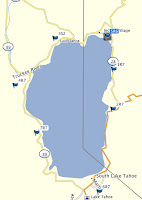
 Exploring ideas around notions of landscape, time,
and states of flux artists Rick Parsons and Katie Lewis collaborated to make a
two-part installation with Lake Tahoe as the point of origin. Parsons and Lewis visited seven different sites
around the lake with the criteria that each site must have a creek or tributary
that feeds into Lake Tahoe.
Exploring ideas around notions of landscape, time,
and states of flux artists Rick Parsons and Katie Lewis collaborated to make a
two-part installation with Lake Tahoe as the point of origin. Parsons and Lewis visited seven different sites
around the lake with the criteria that each site must have a creek or tributary
that feeds into Lake Tahoe.  Referring to the
idea of mapping and data as a way to place themselves in the landscape,
they
used a GPS and plotted out an area of land around the size of a football
field. Within this area they collected natural materials in glass
jars—such as plants,
flowers, dirt, and burnt trees—and ground them into pigments. Each time a
pigment was collected it was recorded with both a photograph and a marker on
the GPS system to pinpoint exactly where within this football field it was
located, again referring to the idea of data collection as a method of
understanding and interacting with the landscape. The mapped area was then
transferred to a grid on a sheet of paper and each pigment was plotted with a
sponge according to its position on the GPS. Two drawings were made for each
site.
Referring to the
idea of mapping and data as a way to place themselves in the landscape,
they
used a GPS and plotted out an area of land around the size of a football
field. Within this area they collected natural materials in glass
jars—such as plants,
flowers, dirt, and burnt trees—and ground them into pigments. Each time a
pigment was collected it was recorded with both a photograph and a marker on
the GPS system to pinpoint exactly where within this football field it was
located, again referring to the idea of data collection as a method of
understanding and interacting with the landscape. The mapped area was then
transferred to a grid on a sheet of paper and each pigment was plotted with a
sponge according to its position on the GPS. Two drawings were made for each
site. 
A total of ninety-eight jars were collected during the site visits and are marked according to the site number and the order in which they were collected. Referring to the idea of sediment and the passage of time the jars are placed according to the same GPS mapping system used during collection, but all seven sites are combined and layered on top of one another to create one composite view.The element of chance and the unknown played an important role in this project. The parameters and methods of working were established before the site visits occurred, but what happened during the visits such as which pigments were found and where, created a point of flux—in a sense the landscape itself determined the final visual outcome. The project also refers to other artistic methods of either interpreting or documenting the landscape such as painting or photography. For example, in the same way a photographer records the landscape the drawings and jars abstractly document the different points around the lake both through the coloring and placement of the pigment.
For a full project tour click on start Prezi.








































